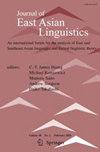代理和非代理动作直接影响事件理解和描述:VOS语言的眼动追踪研究
IF 0.5
3区 文学
0 LANGUAGE & LINGUISTICS
引用次数: 3
摘要
具身认知假说认为,人类的认知从根本上建立在我们与物质世界互动的经验基础上(Barsalou in behavior Brain Sci 22:57 - 609, 1999)。研究表明,身体动作与语言理解过程之间存在双向关联:语言理解似乎激活了隐含的视觉和运动成分(Zwaan和Taylor in J Exp Psychol Gen 135(1):1 - 11,2006),而动作行为似乎促进了相关动作语言的理解(Beilock et al. in Proc Natl Acad Sci USA 105:13269-13273, 2008)。尽管许多研究报告了行动和语言理解之间的联系,但它们之间联系的确切性质仍然存在争议(Chatterjee in Lang Cognit 2:79-116, 2010)。此外,行动在语言产生中的作用尚未得到充分探讨,南岛语的一般语言产生过程也是如此。濒临灭绝的南岛语Truku提供的类型学模式在心理语言学研究和语言生产问题上都没有得到充分的研究。Truku允许在句子中动词和论点的相对位置上具有灵活性,并使用对称的语音系统来标记事件中不同参与者的突出位置。通过与母语为Truku的人合作,我们测试了身体运动是否会立即影响待描述事件中所代表的成分的概念显著性,从而引导说话者的视觉注意力并塑造他们的话语结构。更具体地说,我们调查了说话者在非言语身体动作中作为代理人或病人的参与是否会影响视觉场景中对代理人和病人参与者的初始注视,以及说话者在描述简单及物事件时的语序和语法语音选择。结果显示,肢体动作对言语主体在后续句子构成中的相对位置和显著性以及在线注视模式有显著影响。这些结果为认知加工中的语言-动作联系提供了进一步的支持,并揭示了句子生成的跨语言模式。本文章由计算机程序翻译,如有差异,请以英文原文为准。
Agentive versus non-agentive motions immediately influence event apprehension and description: an eye-tracking study in a VOS language
The embodied cognition hypothesis postulates that human cognition is fundamentally grounded in our experience of interacting with the physical world (Barsalou in Behav Brain Sci 22:577–609, 1999). Research has shown bi-directional associations between physical action and the processes of understanding language: language comprehension seems to activate implied visual and motor components (Zwaan and Taylor in J Exp Psychol Gen 135(1):1–11, 2006), and action behavior seems to facilitate the comprehension of associated action-language (Beilock et al. in Proc Natl Acad Sci USA 105:13269–13273, 2008). Although numerous research studies have reported a link between action and language comprehension, the exact nature of their association remains subject to debate (Chatterjee in Lang Cognit 2:79–116, 2010). Moreover, the role of action in the production of language is under-explored, as are general language production processes in Austronesian languages. The endangered Austronesian language Truku provides typological patterns that are both under-examined in psycholinguistic research and informative for questions of language production. Truku allows flexibility in the relative location of verbs versus arguments in sentence production, and uses a symmetrical voice system that marks the prominence of different participants in an event. Working with native speakers of Truku, we tested whether performing physical motions immediately affects the conceptual saliency of the components represented in a to-be-described event in ways that guide speakers’ visual attention and shape their utterance formulation. More specifically, we investigated whether speakers’ engagement as an agent or patient in a non-speech physical action affects initial eye-fixations on agent versus patient participants in a visual scene, as well as word order and grammatical voice choices in the speakers’ descriptions of simple transitive events. The results revealed significant effects of physical action on the relative location and prominence of agents in subsequent sentence formulation, and on online patterns of eye fixations. These results provide further support for language-action connections in cognitive processing, and shed light on the cross-linguistic patterns of sentence production.
求助全文
通过发布文献求助,成功后即可免费获取论文全文。
去求助
来源期刊

Journal of East Asian Linguistics
Multiple-
CiteScore
0.90
自引率
0.00%
发文量
13
期刊介绍:
The study of East Asian languages, especially of Chinese, Japanese and Korean, has existed for a long time as a field, as demonstrated by the existence of programs in most institutions of higher learning and research that include these languages as a major component. Speakers of these three languages have shared a great deal of linguistic heritage during the development of their languages through cultural contacts, in addition to possible genealogical linkage. These languages accordingly possess various common features. Another important factor that ties them together as a field is that they have shared a common tradition of linguistic scholarship, a tradition that distinguishes itself from the study of western languages. Against this tradition, much recent work has approached these languages from a broader perspective beyond the area, considering them within contexts of general theoretical research, bringing new lights to old problems in the area and contributing to current issues in linguistic theory. But there continues to be good reason for scholars working in this approach to hold a special interest in each other''s work. Especially with the amount of most recent theoretical work on these languages, the field of theoretical East Asian linguistics has been fast growing. The purpose of the Journal of East Asian Linguistics is to provide a common forum for such scholarly activities, and to foster further growth that will allow the field to benefit more from linguistic theory of today, and enable the languages to play a more important role in shaping linguistic theory of tomorrow.
 求助内容:
求助内容: 应助结果提醒方式:
应助结果提醒方式:


